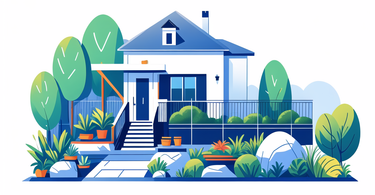Understanding the Role of Garden Fences in Creating a Backyard Oasis
The Benefits of a Well-Defined Garden Space
Garden fences play a crucial role in creating a private outdoor sanctuary. They provide a clear boundary, enhancing the sense of personal space. Fences also add structure to your garden, defining areas for different activities. They can serve as a backdrop for plants, creating a lush, green wall. Moreover, fences offer protection from wind and pests, making your garden more enjoyable. They can also increase property value by improving curb appeal. A well-chosen fence transforms your backyard into a cozy retreat, perfect for relaxation and entertainment.

Achieving the Perfect Balance Between Aesthetics and Functionality
When selecting a garden fence, it's essential to strike a balance between looks and practicality. The fence should complement your home's architecture and garden style. Consider the fence's height, material, and design to ensure it fits your aesthetic vision. At the same time, think about its primary function. Is it for privacy, security, or simply decoration? A good fence should fulfill its purpose while enhancing your garden's beauty. For example, a lattice fence can provide privacy while allowing light and air to pass through. By choosing wisely, you can create a fence that's both beautiful and functional.
Key Considerations When Choosing a Garden Fence
Assessing Your Specific Garden Fence Needs
Before selecting a fence, evaluate your garden's unique requirements. Consider the following factors:

- Privacy level needed
- Security concerns
- Climate and weather conditions
- Local zoning laws and HOA regulations
- Budget constraints
- Maintenance preferences
Think about how the fence will interact with your existing landscape. Will it block desirable views? Does it need to keep pets in or wildlife out? By clearly defining your needs, you can narrow down your options and choose the best fence for your garden. Remember, the right fence should solve problems, not create new ones.
Material and Design: Tailoring Your Fence to Your Garden
The material and design of your fence greatly impact its appearance and function. Common materials include:
- Wood: Classic and versatile
- Vinyl: Low-maintenance and durable
- Metal: Strong and long-lasting
- Composite: Eco-friendly and weather-resistant
Each material has its pros and cons. Wood offers a natural look but requires more upkeep. Vinyl is easy to clean but may lack the charm of wood. Metal fences are sturdy but can be expensive. Composite fences blend durability with aesthetics but may have a higher upfront cost. Choose a design that complements your garden style, whether it's a picket fence for a cottage garden or a sleek panel fence for a modern landscape. The right combination of material and design will enhance your garden's overall appeal.
The Importance of Durability and Maintenance
A garden fence is a long-term investment, so durability is key. Consider how well the fence will withstand your local climate. Will it resist rot, rust, or fading? Some materials, like vinyl, require little maintenance. Others, like wood, need regular staining or painting. Factor in the time and cost of upkeep when making your choice. A durable fence that's easy to maintain will save you money and effort in the long run. It will also keep your garden looking great year after year. Remember, even low-maintenance fences need some care. Regular inspections and minor repairs can prevent bigger problems down the line.
The Best Garden Fences on the Market
Exploring Traditional and Modern Garden Fence Options
Garden fences come in a wide variety of styles, from classic to contemporary. Here are some popular options:

- Picket Fence: A timeless choice for cottage gardens
- Privacy Panel Fence: Ideal for creating a secluded backyard retreat
- Lattice Fence: Offers partial privacy while allowing air and light through
- Wrought Iron Fence: Elegant and durable, perfect for formal gardens
- Bamboo Fence: Eco-friendly option for a natural, tropical look
Each style has its unique charm and functionality. Picket fences create a welcoming atmosphere. Privacy panels offer maximum seclusion. Lattice fences strike a balance between openness and privacy. Wrought iron fences add a touch of elegance. Bamboo fences bring a natural, eco-friendly vibe. Choose the style that best fits your garden's theme and your personal preferences.
How to Install a Garden Fence: A Step-by-Step Guide
Installing a garden fence can be a DIY project or a job for professionals. Here's a basic guide:
- Plan your fence layout and mark the post locations
- Check for underground utilities before digging
- Dig post holes and set posts in concrete
- Install fence panels or boards between posts
- Add any finishing touches like caps or paint
Always check local building codes before starting. Some areas require permits for fences. If you're not confident in your DIY skills, consider hiring a professional. They can ensure your fence is installed correctly and safely. Remember, a well-installed fence will last longer and look better. Take your time and do it right, whether you DIY or hire help.
Maintaining Your Garden Fence for Long-Lasting Beauty
Regular maintenance keeps your fence looking great and extends its lifespan. Here are some tips:
- Clean your fence annually with a mild detergent
- Check for and repair any damage promptly
- Repaint or restain wood fences every few years
- Tighten loose hardware and replace rusted fasteners
- Trim plants away from the fence to prevent moisture damage
Different materials have different maintenance needs. Wood fences may need more frequent care than vinyl or metal. Always follow the manufacturer's care instructions. With proper maintenance, your garden fence can remain beautiful and functional for many years. A well-maintained fence not only looks better but also provides better protection for your garden. Make fence care a regular part of your garden maintenance routine.
